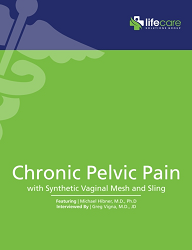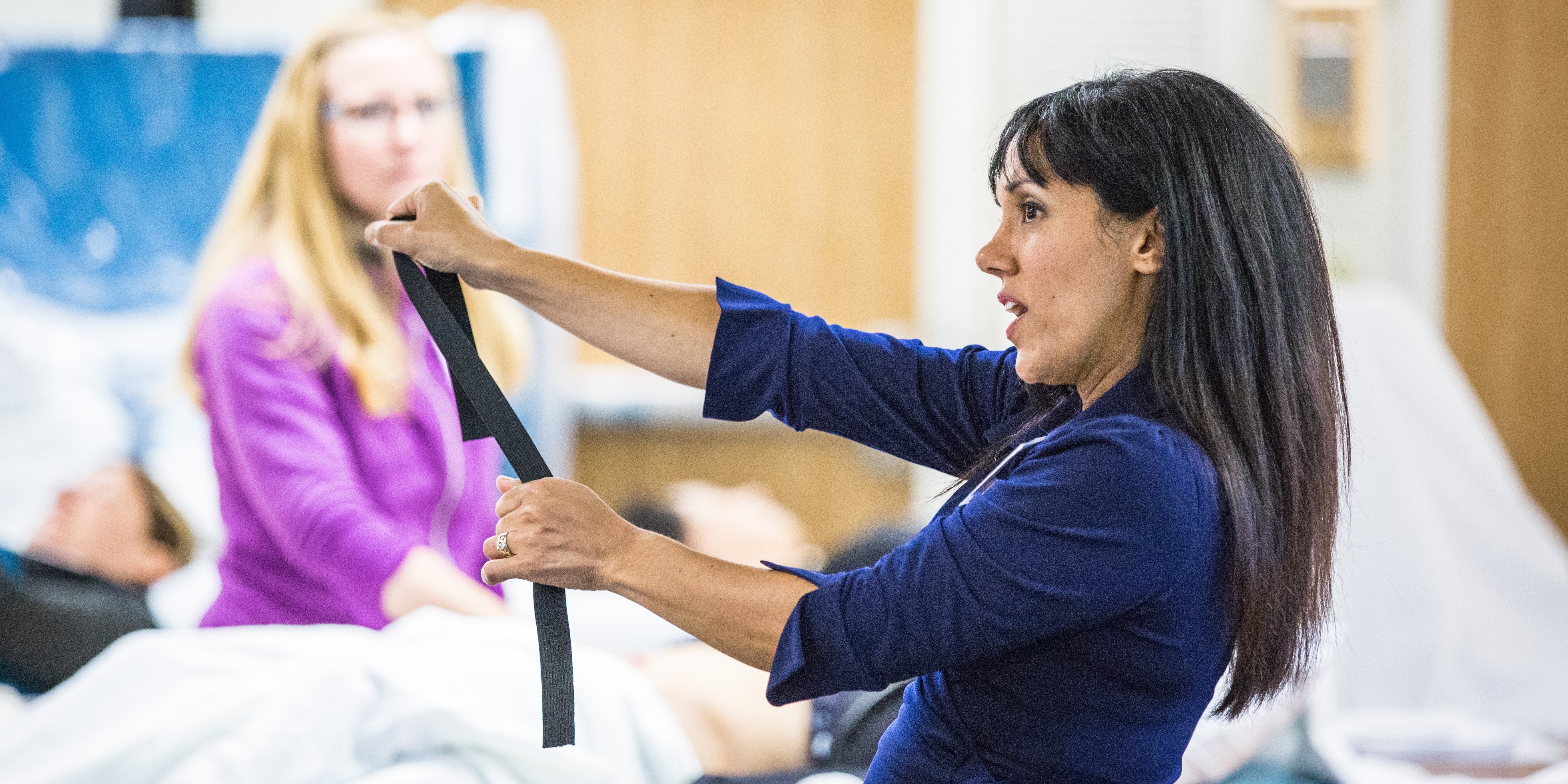Pudendal Neuralgia (PN) is a neuropathic condition that causes patients to suffer chronic pain or numbness. Furthermore, PN is often accompanied by fecal incontinence, urinary incontinence, and numbness of the genitalia. Patients experiencing PN struggle with one of the most difficult nerve conditions and one that affects men and women alike.
Physical therapy has shown itself to be one of the few methods to successfully treat PN. However, few physical therapists have the knowledge, experience, and skills required. Recently, Greg Vigna, M.D., J.D. wrote an article for New York Injury News about pudendal neuralgia. In it, he describes the obstacles facing patients with PN:
"Historically the management of pudendal neuralgia was only available at a select few centers throughout the country. The reasons for this is that pudendal neuralgia was quite rare, often overlooked, and under diagnosed by the medical community. There are only a few doctors in this country who have received the advanced training in the management of this disorder. Even fewer have the advanced surgical training. A great number of physicians do not have a base understanding of the pudendal nerve and are unaware of pudendal neuralgia."
One of the reasons PN is so hard to diagnose, is that the most obvious symptom is intense pain while sitting. Patients associate the feeling with having a foreign body in your rectum or vagina. Men often feel pain while ejaculating or develop erectile dysfunction because of PN.
While women are twice as likely to suffer from PN as men, the condition affects people from all walks of life. PN was termed “cyclists syndrome” by French cyclists. Prolonged driving and sitting are also common causes. Young people who participate in sports, such as cyclists, runners, gymnasts, and horseback riders, also can be affected.
For women, PN frequently occurs immediately after childbirth. Sometimes, the symptoms are temporary. For others, the condition is not. Patients with PN notice symptoms of the condition throughout the day. As a patient’s day progresses, pain generally smarts as a patients activity level rises. These symptoms are often debilitating.
In August, Herman & Wallace will be offering a course on treating and assessing PN. Focusing on the pudendal nerve and pelvis, the course is designed to give medical practitioners the skills they need to rehabilitate those suffering from PN.
The course will be taught by Tracy Sher, MPT, CSCS and Loretta J. Robinson, PT, MS. Tracy is an accomplished pelvic and orthopedic physical therapist, who has presented for the International Pelvic Pain Society and the APTA’s Annual Conference. Loretta co-authored a paper on PN with Dr. Michael Hibner and has long been regarded as a leader in the field. Her practice exclusively serves men and women suffering pelvic dysfunction.
Are you guilty of treating the pelvic floor muscles without inspecting the tissues of the vulvar area or perineal area? A recent posting about clinical pearls by Institute faculty member and Pelvic Guru author Tracy Sher got me thinking about this dilemma. How can we avoid treating pelvic muscle trigger points when the patient has a medical condition requiring immediate intervention, and without which, the trigger points do not stand a chance of resolving? The larger picture is that all pelvic rehabilitation providers must be responsible for an increased awareness of medical issues, pelvic-related pathologies, and how to coordinate referrals.
Experienced therapists tend to have strong skills related to referrals and identifying conditions that require the eyes and ears of a medical provider. Less experienced therapists, in my observation and opinion, have the updated information about medical screening and multiple systems involvement, yet lack the clinical experience to develop an efficient pathway to referral and problem solving. What strategies can improve this issue?
Collaborate
There is much to be gained by the patient when therapists of varying experience level share information, and mentor each other. This requires some humility on the part of both therapists involved, and a huge effort on the part of the employing facility as well as the therapists who aim to find time to review charts, discuss difficult cases, or request that another therapist assess the complex patient. Many sites do not have more than one therapist. What about forming a local study group with the assistance of the the APTA Section on Women's Health, or simply contacting area pelvic rehab providers and doing a quarterly dinner and education session at neighboring clinics? The first response I usually hear is that therapists are in "competition" with these clinics, and that collaboration would be a negative thing. I reject that thought, professionally and personally, as there is plenty of pelvic rehab work to go around, especially with the lack of awareness within the community of our services. Check out this poignant blog post about collaboration.
Consult
Request the opinion of the referring provider whenever possible. Developing a strong relationship with providers is paramount to delivering excellent care. Physicians in this day and age are under severe pressure for being accurate and efficient, and when approached with respect, may develop a habit of seeking your opinion when the patient's condition is perplexing. Likewise, when you have a question or concern, he or she will create time to field the question. Is it possible to invite a referring provider to speak to a group of therapists, or to invite a provider to attend a pelvic rehab lecture with you?
Continue to Learn!
Take a course in medical screening. If you have not taken DPT level courses, what about taking an on-line course in the topic? Or purchase some of the amazing texts from authors including William Boissonnault or Catherine Goodman? Being able to ask the right questions or to communicate effectively about a concern can boost our confidence when contacting providers or when documenting concerns. (I still find myself saying things such as "....there is this odd bump located here and it feels like this...") yet if I can research some options for what that bump would feel like if it were a cyst, a lymph node, a hemorrhoid, etc, then I can discuss with more clarity the true concerns that I have.
Now back to the looking part. Sometimes, looking at the vulvar area or around the male genital area feels uncomfortable for either the therapist, the patient, or for both parties. This issue is the responsibility of the pelvic rehab provider to address. The phrase "fake it 'til you make it" comes to mind, because it is completely acceptable to simply take a deep breath, smile, and pretend to be a little more comfortable than you feel inside; the comfort level will come with practice. If your attitude is "I don't need to see what is going on," well, you are incorrect. What you might find is a lump, a rash, a cut, a bruise, an infection, a suspicious mole, pale skin, or a myriad of other things. A brief and thorough inspection (including under the scrotum or within the vestibular area) are crucial for the patient's wellness. It is possible that the provider has not seen what is going on due to lack of a complete examination or the time between provider examination and your examination.
How do we know what "normal" looks like? This is an area I think we can improve upon in general in pelvic rehabilitation. We are exceptional at education about the muscles, and nerves, and function, yet we might learn how to complete a pelvic muscle examination before learning what lichen sclerosis looks like. The integumentary system is considered to be the largest organ in the body, and if this organ lacks health, certainly the underlying muscles, connective tissues, and nerves can be affected. There are some very helpful resources for us in learning what dermatological conditions look like might affect a patient. Below I have linked some of them for you.
- Blog with link to resources about vulvar skin conditions
- A prior blog post with a link to a terrific article with images of common vulvar skin conditions
- Perianal images including surgical correction
- Images of normal and abnormal anal verge appearances
- Powerpoint available through google scholar with images of vulvar dermatology conditions
In February of 2012, Herman & Wallace founder and faculty member Holly Herman traveled to Riyadh, Saudi Arabia, where she educated the first class of 34 female physical therapists in the art and science of women's health physical therapy. She was accompanied by instructor and H&W friend Fatima Hakeem, PT. You can read more about that adventure here.
Following this intensive 11-day seminar in Riyadh, she returned to the Middle East last Decemeber to teach a similar intensive seminr in Dubai, UAE. You can read more about this trip here.
This winter, Holly will return to Riyadh to teach a six-day intensive offering of Herman & Wallace's Pregnancy and Postpartum series of courses. This course will be targeted towards female physios in the region and will be the first of it's kind.
Stay tuned to Pelvic Rehab Report for more updates on our international travels!

This August, Herman & Wallace is thrilled to be offering a brand new course, Biomechanical Assessment of the Hip and Pelvis in Tampa, FL. This two-day, orthopedic course was developed and is instructed by Steven Dischiavi, MPT, DPT, ATC, COMT, CSCS.
Pelvic Rehab Report sat down with Steve to learn more about his practice, his experience in the clinic and with the Florida Panthers hockey team and this brand new course.
What can you tell us about this continuing education course that is not mentioned in the "course description" and "objectives" that are posted online?
This course was designed to bring a sports medicine approach to pelvic health clinicians. The exercise philosophy is intimately integrated into the pelvic health specialty. As a PT who currently works with a NHL hockey team I am constantly challenged by a sport dominated with pelvic injury. It was crucial for me to learn more about a specialty that has always been known to me as “women’s health.” I feel this course blends some of the knowledge of the pelvic health specialty with the sports medicine arena to develop a series of functional exercises designed to treat individuals with pelvic issues.
What inspired you to create this course?
I have seen several exercise regimes targeted at the “core” for both the highest functioning athlete to the PT client whose functional goals are far less. None of these programs target the entire human system from an anatomic, orthopedic, and neurologic approach. I was once told “all orthopedic clients are neurologic clients, but not all neurologic clients are orthopedic clients.” I think this is a good axiom to describe how you may start treating your orthopedic clients with techniques typically reserved for neurologic clients. The exercise system uses orthopedic strategies applied with a neuroscience approach all based in functional anatomy.
What resources and research were used when writing this course?
This course was bred from many different approaches and thought processes. The main influences to my philosophy come from Thomas Meyers and his work with “Anatomy Trains.” Diane Lee is a clinician whom I dearly respect and she has heavily influenced my thought process with regard to the pelvis. Although, I felt that Diane Lee’s approach to corrective exercise is where the greatest demand lay. I cite numerous studies on the hip, pelvis, and rehabilitation, all of which can be found in the course manual. The manual therapy approach I utilize is mainly influenced by the Ola Grimsby Institute, where my manual therapy certification was obtained. As with any clinician, the philosophy behind their practice is a unique blend of art and science reflective of their experiences and exposures to the profession.
Can you describe the clinical/treatment approach/techniques covered in this continuing education course?
The whole focus of this course is to allow an individual to function on a centered or balanced pelvis. This is first achieved through a sound physical exam, which will be reviewed in the course. The course will offer manual techniques to help correct pelvic imbalance. The bulk of the class is then focused on the corrective exercises and aims to strengthen the whole body functionally through movement efficiency. The class should not be thought of as a manual therapy course, although there are manual strategies offered, it is not the primary focus of the course.
Why should a therapist take this course? How can these skill sets benefit his/ her practice?
The profession of outpatient physical therapy needs to change. Fitness and wellness centers are offering more and more programs targeting areas that should remain in the realm of physical therapy. This course outlines an exercise system that can be utilized by the physical therapist to cover a wide variety of clients. These exercises can be used for an elderly client who needs to move more efficiently in order to achieve a functional task. These exercises can also be used, for example, in a circuit fashion for the highest-level athlete. I have seen success with these exercises in my private clinic as well as with the professional athletes I work with on a daily bases. The skills learned, if implemented correctly, are a great way to market more than just physical therapy to the community.
If you'd like to learn more about these techniques and approaches from Steve, don't miss his course in Tampa in August. Seats are limited, so let us know if we can save you a seat!
Life Care Solutions Group Publishes Free eBook for Women with Chronic Pelvic Pain
Experienced Gynecological Surgeon Michael Hibner, MD, PhD, has released a free eBook for women with Chronic Pelvic Pain. The eBook, written along with Greg Vigna, MD, JD, contains important information about chronic pelvic pain, especially that onset by Synthetic Vaginal Mesh complications. PR News wire is reporting that Life Care Solutions Group has published this eBook as a next step guide toward healing from Pelvic Organ Prolapse and Stress Urinary Incontinence.
Herman & Wallace offers many continuing education courses that can help therapists treat this under-served clientele. We are especially proud of our Differential Diagnostics of Chronic Pelvic Pain course, which empowers participants to diagnose and treat the many causes of chronic pelvic pain.
In this article titled "Too Posh to Push?"the value of elective cesarean (or "c-section") deliveries for childbirth is revisited. Statistics in Britain are referenced, as rates for the procedure have increased from 4.5% in 1970 to nearly 25% today. This trend is stated to have occurred without a corresponding obstetric need for the the procedure. The US has experienced a similar debate, with stories of women demanding an elective surgery, sometimes for the preservation of the pelvic floor, other times because she is interested in avoiding the pain of pushing. Some providers also promote elective cesareans for birth, perhaps due to their own beliefs about potential benefits, or for the value of having more control over a schedule. Regardless of the motivations and beliefs of the patients or providers, pelvic rehabilitation providers can land in the middle of such an important discussion.
The choice about desired birth practices is between a mother, her family, and her providers. At no time is it appropriate for a pelvic rehab therapist to impose an opinion upon a woman who is pregnant. It is, however, most appropriate to answer questions that may arise in relation to musculoskeletal health and about discussions the patient may be hearing or reading about elective cesareans. The literature in the past decade has been decidedly in favor of avoiding vaginal births in order to avoid pelvic floor injuries. The other half of the story is that birth is not the only factor in pelvic floor health and injury, and that cesarean deliveries also carry risks- some of those risks are lessened in a vaginal birth.
Basic information about a cesarean delivery are available on many sites, including the National Institute of Health's MedLinePlus. While c-sections are always described as a "safe" surgery, all surgeries carry risks. Personally, I have been amazed at the nonchalance of surgeons who give an air of "no-big-deal" for common surgeries that is contrasted with the informed consent waiver a person is asked to sign before entering the operating room. All surgeries have risks. While it is acknowledged that vaginal deliveries are associated with increased incontinence, the actual cause of the pelvic floor injuries cannot be directly correlated with the delivery itself.
A recent study from Brazilevaluated the use of 3D perineal ultrasound to measure pelvic floor injuries at the second postpartum day. 35 patients were allocated to groups according to delivery type: elective cesarean (10), vaginal delivery (16), and forceps delivery (9), with episiotomy performed in 3 of the deliveries. The urogenital hiatus was found to be significantly increased from the cesarean group, at 12.4 cm, to 17 cm in the vaginal delivery group and 20.1 cm in the forceps delivery group. 3 of the 25 women in the non-cesarean groups had a tear of the levator ani. The authors recommend routine assessment of pelvic floor integrity following childbirth. While vaginal birth may be correlated with increased rates of incontinence and prolapse, a recentstudy that evaluated 84 women (grouped by mode of delivery) did not find any correlation between mode of delivery and return to sexual function.
The controversy is far from over, as we continue to see research that aims to answer questions about long-term benefits for pelvic floor health in relation to cesarean versus vaginal deliveries. As is often the case, the swinging pendulum that headed towards recommending elective cesareans will likely swing back towards the middle ground when more research comes in, and when more providers and women understand the total implications of various birth practices on not only the mother and child, but on families and communities as well. In the meanwhile, pelvic rehabilitation providers will continue to support a woman regardless of birth history, focusing instead on patient presentation, goals, and examination findings when applying best practices.
We are excited to announce Herman & Wallace instructor Ginger Garner, PT, MPT, ATC, PYT will speak at the National Athletic Trainers’ Association’s (NATA) 64th Annual Meeting and Clinical Symposia this June. Her advanced presentation, titled Yoga Pulls Double Duty: Establishing Controlled Flexibility in Athletes, has already sold out!

According to Ginger, yoga has been used as a theoretical healing system for more than five-thousand years. In 2001, she founded Professional Yoga Therapy Studies, an organization that blends yoga, sports medicine, and physical therapy curricula to educate clinicians and patients alike. Her medical yoga undergraduate, graduate, post-graduate, and medical continuing education programs are the first of their kind in the US. While her clinical focus ranges from orthopaedics to public health education, Ginger considers maternal health her most important work.

Herman & Wallace instructors Bill Gallagher PT, CMT, CYT and Richard Sabel MA, MPH, OTR, GCFP are currently leading a four-session workshop for men who recently underwent prostate surgery. They recently completed the first two sessions and shared their story and experience with Pelvic Rehab Report:
For the past few weeks, we’ve had a unique experience: leading a four-session workshop for 22 men recovering from prostate surgery. This experience was unique in that it's rare to get a group of men together to discuss health issues- it happens...about as often as congress reaches a bipartisan agreement!
So far it's been an amazing journey. At the first session we did a quick go round, well, actually not so quickly, as each participant had a story to tell. Things picked up when one participant mentioned he was using a penile clamp. Sex, sports, politics couldn't compete in that moment for the groups attention. (Perhaps the details will be shared in another blog.) For now, the key point we'd like to make is that groups work well for this type of practice. Obviously, individual treatment is imperative, but groups help foster the "new habits" learned in therapy and, perhaps more importantly, from other group members. The mutual support and sharing of information can't be beat.
Given there are only four one-hour-and-fifteen minute sessions, choosing the "lessons," took a little thought. Ultimately we selected four from the Integrative Techniques for the Pelvic Floor & Core Function: Weaving Yoga, Qigong, Feldenkrais & Conventional Therapies live course and online course series that aims to reintegrate of the pelvic floor with the core and full body movement. Below is an overview of each lesson:
Lesson 1 - The Pelvic Breath: The pelvic breath serves as the foundation for the program. In this lesson, participants begin to develop an awareness of the pelvic floor; sense how it moves in relation to the respiratory diaphragm; gently contract and release the pelvic floor as a whole and in sections: right, left, front and back. This focus helps participants develop a keener awareness of the pelvic region and notice differences such as the right side is tighter than the left, how one side can be sensed more clearly, or noticing that while doing Kegel exercises how the back, anal portion, was contracting, not the front.
The pelvic floor is also referred to as the pelvic diaphragm. Given we breathe in and out over 20, 000 times per day, reeducating the pelvic floor to dance with the respiratory diaphragm, is key to maintaining the pelvic floor’s suppleness. By focusing on the breath, this lesson also promotes the relaxation response.
Lesson 2 – Standing Stake: Standing Stake, which goes by a variety of names, is practiced within Tai Chi Quan and Qigong and is an important part of internal martial arts training. In Standing Stake, the participant stands with their feet shoulder width apart, toes straightforward. The hips and knees are slightly bent. The tailbone is released down as if it a weight was attached to the coccyx. The chin is slightly tucked while imaging the head floats upward. The arms are protracted, as if hugging a wide tree, while keeping the shoulders relaxed down and out. There are a few more adjustments, but this gives you an idea, which might have you asking…and how does this relate to the pelvic floor? First, after developing an awareness of the pelvic breath in the first lesson, is it possible for the participant to allow the pelvic diaphragm to move in concert with the respiratory diaphragm, while the upper and lower extremities are engaged? Can the rest of the body maintain a relatively relaxed state in this form? If not, can the holding or tension be identified and released? Standing Stake ups the ante, helping the nervous system relearn that the pelvic breath can be available even when other parts of the body are actively engaged.
Participants are also guided through a short experiential comparing how locked versus slightly bent knees impacts their breath, lower back/pelvic comfort and stability. Participants typically report that when the knees are slightly bent, the breath is deeper, the pelvis and back feel more comfortable and easy to move, the feet are more grounded and…they “feel” their quadriceps. Many people experiencing pelvic discomfort tend to lock their knees and this is an effective strategy to foster the “new Habit”…of keeping the knees slightly bent when doing everyday activities such as microwaving food or waiting on a line at the store. Not bad for one activity.
Lesson 3 - Coordination of the Pelvic Floor with the Obturator Internus and Adductor Muscles: This lesson builds on the integration of the pelvic floor with the core, obturator internus and adductor muscles. The participant first learns to coordinate the pelvic breath while contracting the obturator internus and adductor muscles and then adds pursed lip breathing or Ujjayi breath to activate the abdominals. On the first go round; it can feel like juggling three or more balls, but by having participants work gently and easily, the coordination begins to emerge.
Lesson 4 - Integrating the Pelvic Floor into Everyday Movements: How many people adhere to their home exercise program? Not enough. In this final lesson, the participants learn to engage the pelvic floor into everyday movements such as sit-stand, lifting objects, bridging and going up stairs. After all that’s the goal…to help the nervous system relearn how to use the pelvic floor muscles in everyday activities, which will help maintain their strength and suppleness.
Broadly speaking this work can also be seen within the context of energy conservation and joint protection, as the powerful muscles of the pelvic floor “reassume” their role in everyday movements, thereby contributing to the health, function and well-being of our clients.
So far, two weeks into the program, we’ve covered the first 2 lessons and all is going well. Our next blog will highlight the participants’ reaction and comments, along with any other interesting anecdotes that arise.
If you would like to contact Bill or Richard, you can do so through their website, EastWestRehab.com

Our Pelvic Rehab Report blogger sat down with Dr. Heather Howard, the instructor of our Sexual Health Clinical Toolkit course, to talk about her course, her practice, and the experience and knowledge she brings to the field of pelvic rehab. Here's what Heather had to say:
What inspired you to create this course?
This course was inspired by my gratitude to the physical therapists who helped me through my own debilitating pelvic pain crisis. The support I received, coupled with the lack of sexuality research and resources for the sexual effects of my condition, led me to become a sexologist and mind-body health facilitator. My mission as a sexologist is to improve sexual health care for all people. In my clinical practice, I help people meet their sexual goals by providing relevant education and skills training. I can help even more people by sharing my tools, resources, and clinical perspective with women's health care providers.
What resources and research were used when writing this course?
In over a decade of collaborating with women's health PTs as a client, researcher, clinician and educator, I have learned the extent to which patients are looking to their PTs for sexual advice, and how PTs are providing sexuality education and counseling on a daily basis. I have also learned about the challenges new and experienced PTs face in providing sexual solutions and what training they would most appreciate in this area. Many of those challenges were revealed in the natural course of my collaboration, and I decided to gain a thorough understanding by conducting a mini-study which consisted of asking co-investigating PTs in my dissertation research about what tools and training they would find helpful in supporting their clients with the sexual challenges they face. There were 12 PTs in the 9 co-investigating PT and medical practices for my dissertation, and I created a list of requested tools and training from those interviews. I have covered most of those requests in this course. I also conducted extensive literature reviews for both my dissertation on integrating sexual response in interventions for pelvic pain, and for a published article on sexual adjustment counseling for women with chronic pelvic pain. The literature establishes what is needed, such as what most of us see in clinical practice: that patients with CPP report more sexual problems than patients with any other type of chronic pain; that a multimodal, multidisciplinary approach is to optimal for treating pelvic pain; that pain management and psychotherapy do not necessarily lead to improved sexual function for people with pelvic pain; and what elements of are needed in sexuality education to implement change. I will address the elements contained in this course later in this interview, which were determined based on the literature and my own interviews with women's health PTs. While research describes what this large population is missing in terms of sexuality adjustment support, it offers few practical solutions for the problem. Clinical protocols and educational resources for sexual rehabilitation for people with chronic health conditions are not well defined or researched yet, so I have built my own educational and clinical approach based on well-established sexuality counseling and embodiment techniques. The sexuality information I teach is based on the research and methodologies of experienced sexuality researchers and counselors that date back to Alfred Kinsey, William Masters and Virginia Johnson, Helen Sanger Kaplan, Jack Annon, and William Hartman and Marilyn Fithian. The experiential mind-body health approaches that I utilize borrow from the traditions of Voice Dialogue, Body Dialogue, Mindfulness, and Somatic Experiencing, all of which are taught in Somatic Psychology programs. I hope to conduct more clinical research soon to add to the literature.
What can you tell us about this continuing education course that is not mentioned in the "course description" and "objectives" that are posted online?
This course provides attendees with a personalized clinical toolkit, which consists of a framework for sexual health management, as well as practical sexual solutions for patients. Attendees improve their ability to conduct sexual health assessments and suggest innovative and relevant sexual solutions and resources. We also discuss approaches to facilitate patient embodiment, which is an important component for pain management and sexual satisfaction. Even the most experienced providers gain new approaches and a deeper understanding of the problems they see every day.
Can you describe the clinical/treatment approach/techniques covered in this continuing education course?
Sexual health is a vast topic and the majority of the courses out there focus on teaching sexuality information. The problem is that information alone is rarely sufficient for health care providers to integrate what they have learned in a course into their clinical practices. Research has shown that the elements of sexuality education that are needed for effective implementation are as follows:
1. Sexuality information (aimed at improving knowledge and resources)
2. Sexuality attitudes self-assessment (aimed at helping providers become more comfortable with a broad spectrum of sexual attitudes and behaviors, and more aware of their personal biases and "blind spots," so that they can provide a safer space for sexual discussions)
3. Sexuality counseling practice and supervision (aimed at improving professional confidence and appropriate practical solutions)
I am most concerned about optimizing clinical implementation, so I offer some of all 3 elements in this course, with an emphasis on #3. This course complements other available courses in sexuality information (such as the upcoming H&W ISSWSH course on sexual medicine), sexuality attitudes assessment (such as the H&W Sexual Spectrum Education course coming soon), and sexuality counseling (AASECT conferences).
Why should a therapist take this course? How can these skill sets benefit his/ her practice?
Patients look to their women's health care providers for sexual advice, and most providers offer excellent support and advice with little formal training in the area of human sexuality. Patients benefit from a methodical approach to care, and a sound methodology is never more important than with a topic as sensitive as sexuality. My more than 1500 class hours of training in human sexuality have helped me see sexuality problems from a broad perspective and re-framing client problems is often as important as the specific rehabilitation solutions we offer. As a result, many providers who take this course see sexuality through a new lens, which can have benefits on a professional and personal level. They also become familiar with the variety of tools and solutions available to help their patients, many of which they integrate into their own practices.
Don't miss the chance to learn more from Heather! The next offering of this course is in San Diego, CA on June 22-23 - Register today!
Pelvic rehabilitation providers tend to have personalities that inspire patients to share intimate concerns and issues. One issue that we can play a part in bringing to light is that of medication usage for male sexual performance. Viagra, or the generic version, sildenafil, is a drug that improves blood flow to the penis. It is also one of the the most counterfeited drugs in the world, according to this report. The issue has been in the media for several reasons in recent weeks, with counterfeit manufacturing as one of the concerns.
The United States Food and Drug Administration recently issued a warning about a recall for an over-the-counter male sexual enhancement supplement, "Lighthening Rod," because the supplement contained an undeclared amount of the medication sildenafil. What's the harm? Drugs.com lists 34 major drug reactions for sildenafil, including blood pressure changes (hypotension) or other cardiac effects when taken with nitroglycerines. A national study completed in Australia reports that erectile dysfunction may be a clinically relevant predictive tool for cardiovascular risk, and it may be that men are not sharing information about their sexual function with providers due to embarrassment. In fact, in a news report about a presentation at the American Urologic Association, research presented found that only 25% of men with erectile dysfunction seek treatment.In what has been described as an unprecedented move, Viagra has now made the drug available for purchase on its website, issuing a warning about acquiring the drug without a prescription or ordering a counterfeit drug. While this approach may help to avoid black market purchases of the medication, it also may allow men who don't feel comfortable filling prescriptions for the drug to purchase it in the privacy of their own home.
In terms of our role in helping men avoid the pitfalls of the diagnosis of erectile dysfunction as well as the potential harm from medication available without a prescription, we can start by asking more questions. A good question to start with is "Are there any other supplements or medications that are not on your medication list?" or "Are there any medications or supplements that you purchase from the internet or from a local store?" We can also be sure to include questions about sexual function and health on patient intake forms, and include such verbal questions in our history taking. Because the patient may not feel comfortable on a first visit discussing intimate issues such as erectile dysfunction, in our education of the patient we can provide anatomy and physiology lessons related to sexual function. For any patient who admits to purchasing sexual enhancement drugs that have questionable contents, the patient should be referred to his medical provider to discuss the issue immediately, and the patient can be instructed in the potential adverse effects and in the need to discontinue such medications.
Many pelvic rehabilitation providers are more comfortable discussing sexual health with female patients than with male patients. This topic may be an excellent place to start when it comes to ensuring that our male patients have a place where they can feel safe discussing such sensitive issues, and where they can receive the most current information about their issues. To learn more about erectile dysfunction in general, you can visit sites such as Medline where interactive educational modules can be found.
By accepting you will be accessing a service provided by a third-party external to https://hermanwallace.com./















































